Induction Motor PI Observer with Reduced-Order Integrating Unit
Abstract
1. Introduction
2. Methods
2.1. Mathematical Model of an Induction Motor
2.2. PI Observer and Integrating Unit Order Reduction Idea
2.3. PIr Observer of an Induction Motor
3. Results
4. Discussion
5. Conclusions
Author Contributions
Funding
Institutional Review Board Statement
Informed Consent Statement
Conflicts of Interest
References
- Laatra, Y.; Lotfi, H.; Abdelhani, B. Speed Sensorless Vector Control of Induction Machine with Luenberger observer and Kalman Filter. In Proceedings of the 2017 4th International Conference on Control, Decision and Information Technologies (CoDIT’17), Barcelona, Spain, 5–7 April 2017; pp. 5–7. [Google Scholar] [CrossRef]
- Wang, F.; Zhang, Z.; Mei, X.; Rodríguez, J.; Kennel, R. Advanced Control Strategies of Induction Machine: Field Oriented Control, Direct Torque Control and Model Predictive Control. Energies 2018, 11, 120. [Google Scholar] [CrossRef]
- Kuchar, M.; Palacky, P.; Simonik, P.; Strossa, J. Self-Tuning Observer for Sensor Fault-Tolerant Control of Induction Motor Drive. Energies 2021, 14, 2564. [Google Scholar] [CrossRef]
- Toumi, D.; Segueir Boucherit, M.; Tadjine, M. Observer-based fault diagnosis and field oriented fault tolerant control of induction motor with stator inter-turn fault. Arch. Electrical Eng. 2012, 61, 165–188. [Google Scholar] [CrossRef]
- Tran, C.D.; Palacky, P.; Kuchar, M.; Brandstetter, P.; Dinh, B.H. Current and Speed Sensor Fault Diagnosis Method Applied to Induction Motor Drive. IEEE Access 2021, 9, 38660–38672. [Google Scholar] [CrossRef]
- Kubota, H.; Matsuse, K.; Nakano, T. DSP-based speed adaptive flux observer of induction motor. IEEE Trans. Ind. Appl. 1993, 27, 344–348. [Google Scholar] [CrossRef]
- Białoń, T.; Pasko, M.; Niestrój, R. Developing Induction Motor State Observers with Increased Robustness. Energies 2020, 13, 5487. [Google Scholar] [CrossRef]
- Azzoug, V.; Menacer, A.; Pusca, R.; Romary, R.; Ameid, T.; Ammar, A. Fault Tolerant Control for Speed Sensor Failure in Induction Motor Drive based on Direct Torque Control and Adaptive Stator Flux Observer. In Proceedings of the International Conference on Applied and Theoretical Electricity (ICATE), Craiova, Romania, 4–6 October 2018; pp. 1–6. [Google Scholar] [CrossRef]
- Aziz, A.G.M.A.; Rez, H.; Diab, A.A.Z. Robust Sensorless Model-Predictive Torque Flux Control for High-Performance Induction Motor Drives. Mathematics 2021, 9, 403. [Google Scholar] [CrossRef]
- Zaky, M.S.; Khater, M.; Yasin, H.; Shokralla, S.S. Review of different speed estimation schemes for sensorless induction motor drives. J. Electr. Eng. 2008, 8, 102–140. [Google Scholar]
- Kadrine, A.; Tir, Z.; Malik, O.P.; Hamida, M.A.; Reatti, A.; Houari, A. Adaptive non-linear high gain observer based sensorless speed estimation of an induction motor. J. Franklin Inst. 2020, 357, 8995–9024. [Google Scholar] [CrossRef]
- Fnaiech, M.A.; Guzinski, J.; Trabelsi, M.; Kouzou, A.; Benbouzid, M.; Luksza, K. MRAS-Based Switching Linear Feedback Strategy for Sensorless Speed Control of Induction Motor Drives. Energies 2021, 14, 3083. [Google Scholar] [CrossRef]
- Najafabadi, T.A.; Salmasi, F.R.; Jabehdar-Maralani, P. Detection and Isolation of Speed-, DC-Link Voltage-, and Current-Sensor Faults Based on an Adaptive Observer in Induction-Motor Drives. IEEE Trans. Ind. Electron. 2011, 58, 1662–1672. [Google Scholar] [CrossRef]
- Zhang, Z.; Gultekin, M.A.; Bazzi, A.M. State-space Modeling of Multi-mode-controlled Induction Motor Drive. In Proceedings of the IEEE International Electric Machines & Drives Conference (IEMDC), Virtual Conference, Hartford, CT, USA, 17–20 May 2021; pp. 1–5. [Google Scholar] [CrossRef]
- Pimkumwong, N.; Wang, M.S. Full-order observer for direct torque control of induction motor based on constant V/F control technique. ISA Trans. 2018, 73, 189–200. [Google Scholar] [CrossRef] [PubMed]
- Nazari, S.; Shafai, B. Distributed Proportional-Integral Observers for Fault Detection and Isolation. In Proceedings of the IEEE Conference on Decision and Control (CDC), Miami Beach, FL, USA, 17–19 December 2018; pp. 6328–6333. [Google Scholar]
- Wang, X.T.; Yu, H.H. Generalized PI observer design for descriptor linear system. Arch. Cont. Sci. 2019, 29, 585–601. [Google Scholar]
- Białoń, T.; Lewicki, A.; Pasko, M.; Niestrój, R. Parameter selection of an adaptive PI state observer for an induction motor. Bull. Pol. Acad. Sci. Tech. Sci. 2013, 61, 599–603. [Google Scholar] [CrossRef][Green Version]
- Gao, Z.; Habetler, T.G.; Harley, R.G.; Colby, R.S. A Sensorless Adaptive Stator Winding Temperature Estimator for Mains-Fed Induction Machines with Continuous-Operation Periodic Duty Cycles. IEEE Trans. Ind. Appl. 2008, 5, 1533–1542. [Google Scholar]
- Espinoza-Trejo, D.R.; Campos-Delgado, D.U.; Martinez-Lopez, F.J. Variable Speed Evaluation of a Model-Based Fault Diagnosis Scheme for Induction Motor Drives. In Proceedings of the IEEE International Symposium on Industrial Electronics, Bari, Italy, 4–7 July 2010; pp. 2632–2637. [Google Scholar]
- Hussein, A.A.; Salih, S.S.; Ghasm, Y.G. Implementation of Proportional-Integral-Observer Techniques for Load Frequency Control of Power System. In Proceedings of the 8th International Conference on Ambient Systems, Networks and Technologies, ANT-2017 and the 7th International Conference on Sustainable Energy Information Technology, SEIT 2017, Madeira, Portugal, 16–19 May 2017; pp. 754–762. [Google Scholar]
- Białoń, T.; Lewicki, A.; Niestrój, R.; Pasko, M. Stability of a proportional observer with additional integrators on the example of the flux observer of induction motor. Electrical Rev. 2011, 87, 142–145. [Google Scholar]
- Krzemiński, Z.; Lewicki, A.; Morawiec, M. Speed observer based on extended model of induction machine. In Proceedings of the IEEE International Symposium on Industrial Electronics, Bari, Italy, 4–7 July 2010; pp. 3017–3112. [Google Scholar]
- Białoń, T.; Lewicki, A.; Pasko, M.; Niestrój, R. Non-proportional full-order Luenberger observers of induction motors. Arch. Electrical Eng. 2018, 67, 925–937. [Google Scholar]
- IEEE. IEEE Standard Definitions of Basic Per Unit Quantities for Alternating-Current Rotating Machines, IEEE Std 86-1975; The Institute of Electrical and Electronics Engineers Inc.: New York, NY, USA, 1975; pp. 1–10. [Google Scholar]
- Popescu, M. Induction Motor Modelling for Vector Control Purposes; Helsinki University of Technology: Helsinki, Finland, 2000; 144p, ISBN 951-22-5219-8. [Google Scholar]
- Amrane, A.; Larabi, A.; Aitouche, A. Unknown input observer design for fault sensor estimation applied to induction machine. Math. Comput. Simul. 2020, 167, 415–428. [Google Scholar] [CrossRef]
- Taherzadeh, M.; Hénao, H.; Capolino, G.A. State of the art of torque observers for condition monitoring of AC drives. In Proceedings of the 2021 IEEE Workshop on Electrical Machines Design, Control and Diagnosis (WEMDCD), Virtual Conference, Modena, Italy, 8–9 April 2021; pp. 289–296. [Google Scholar] [CrossRef]
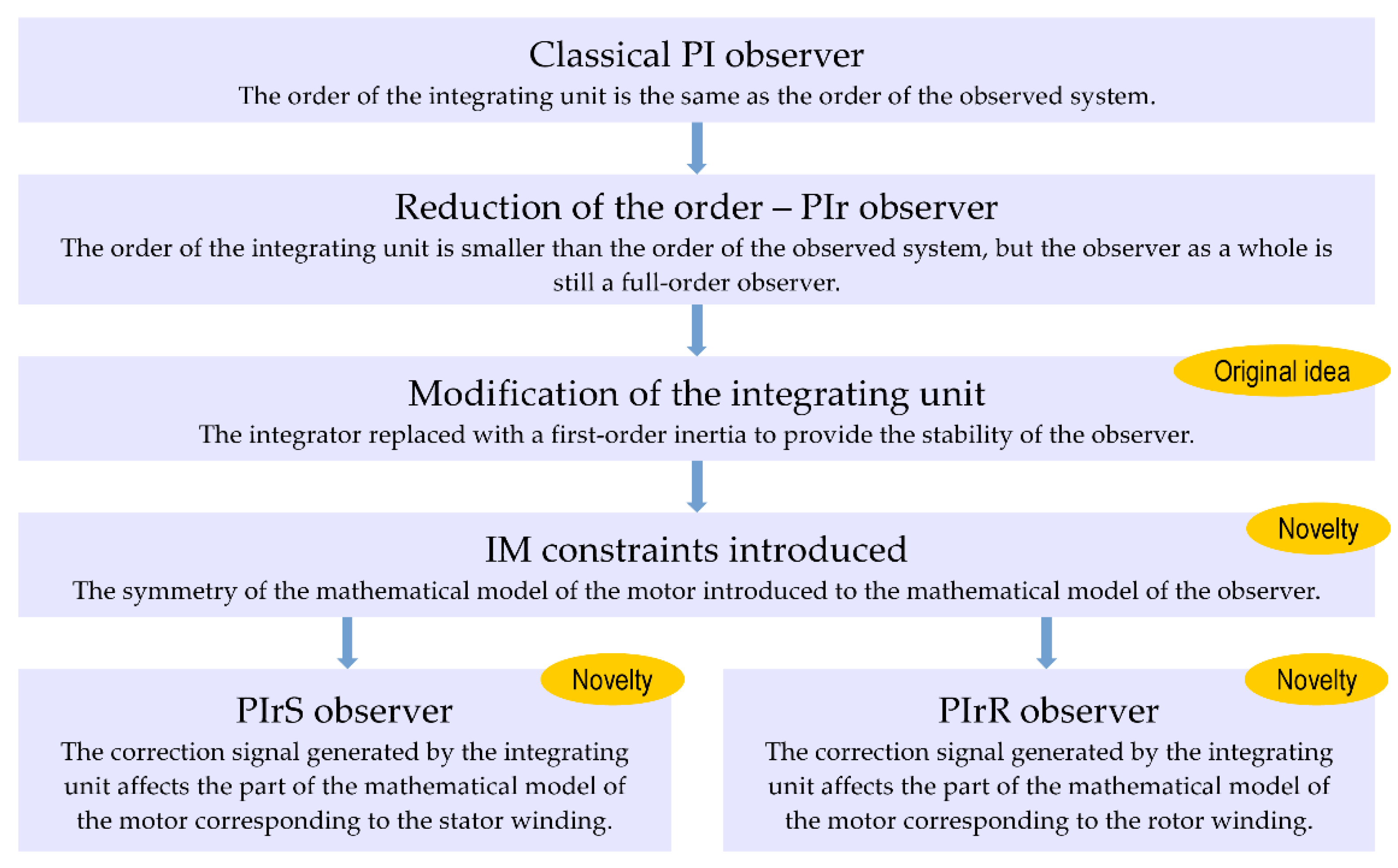
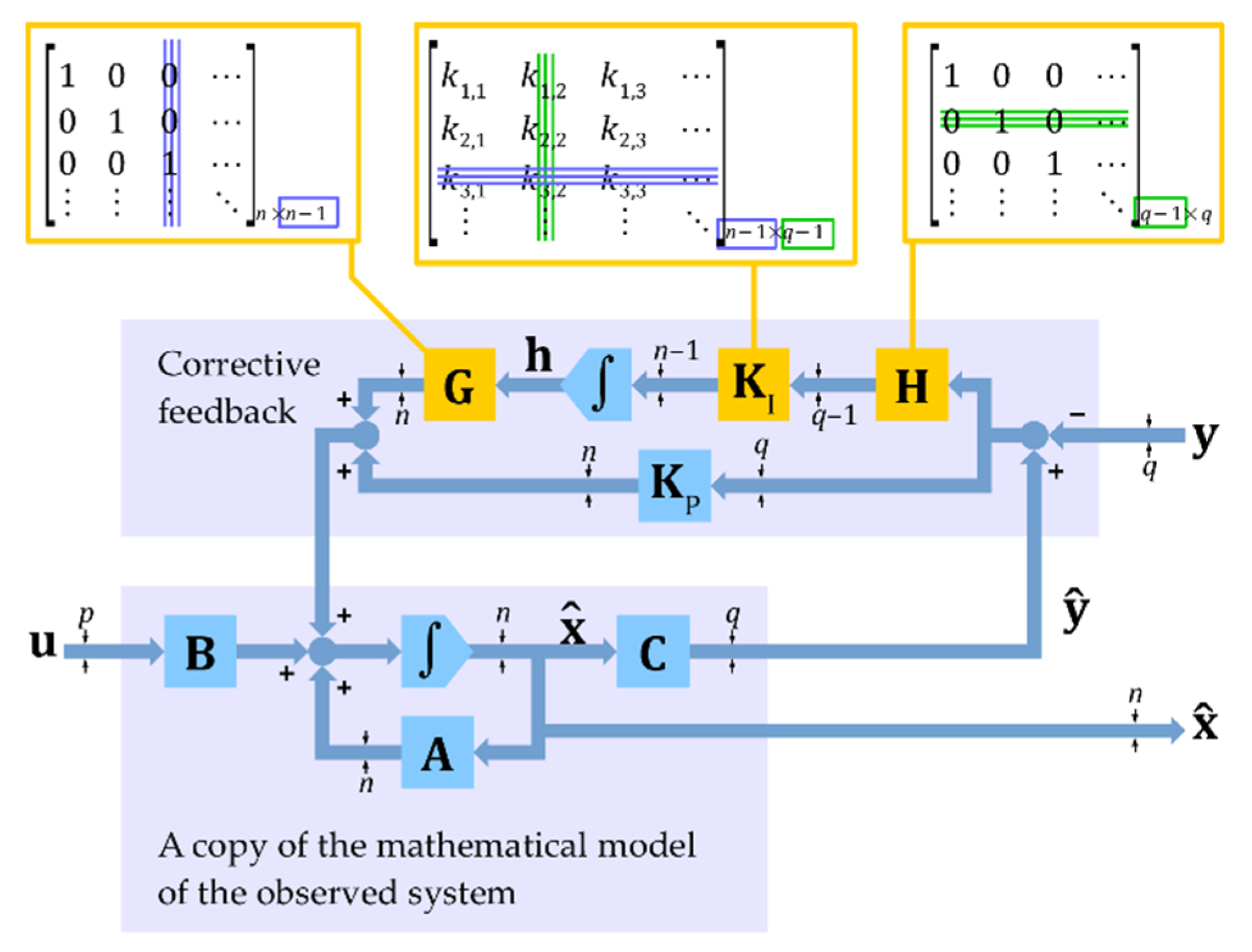



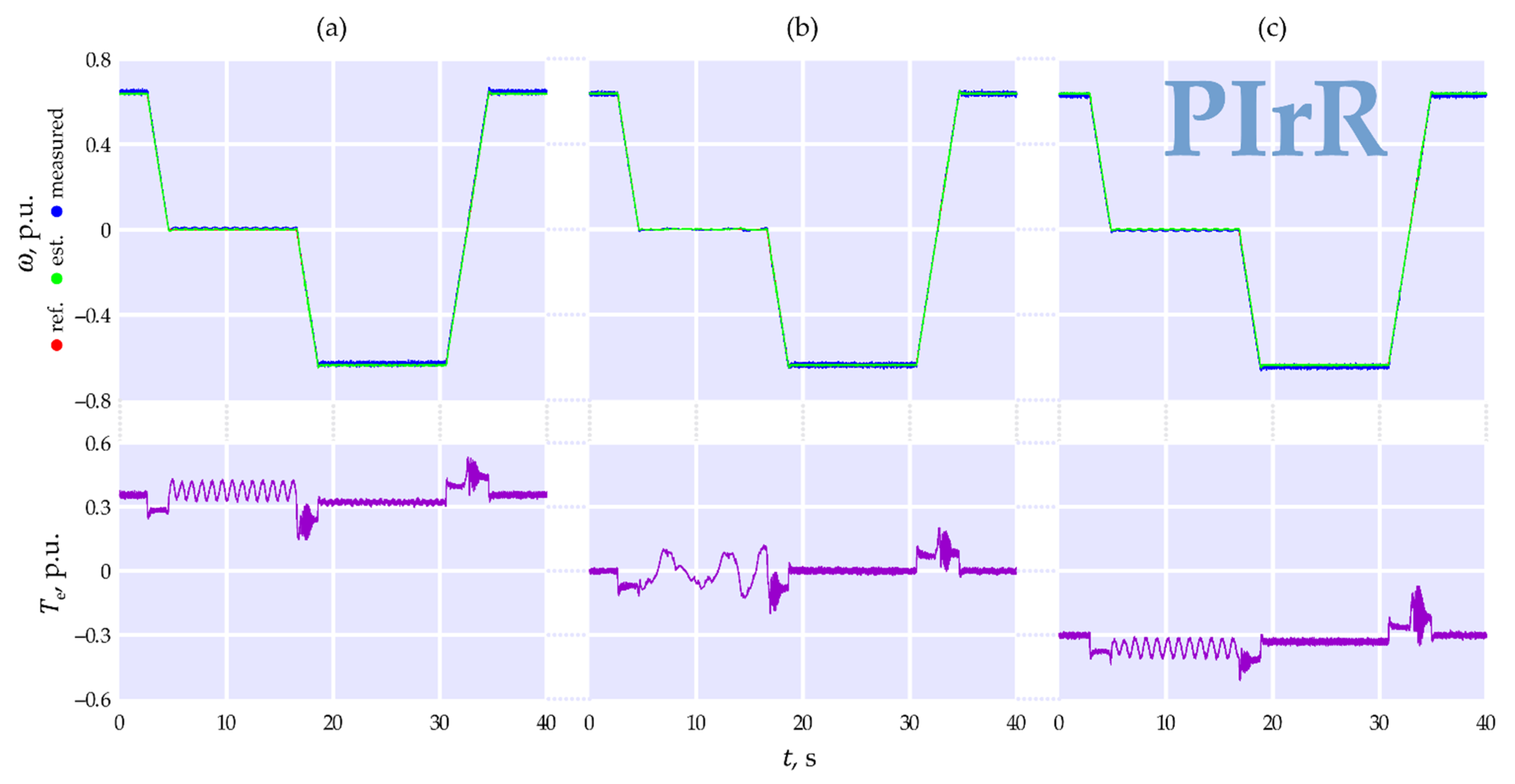
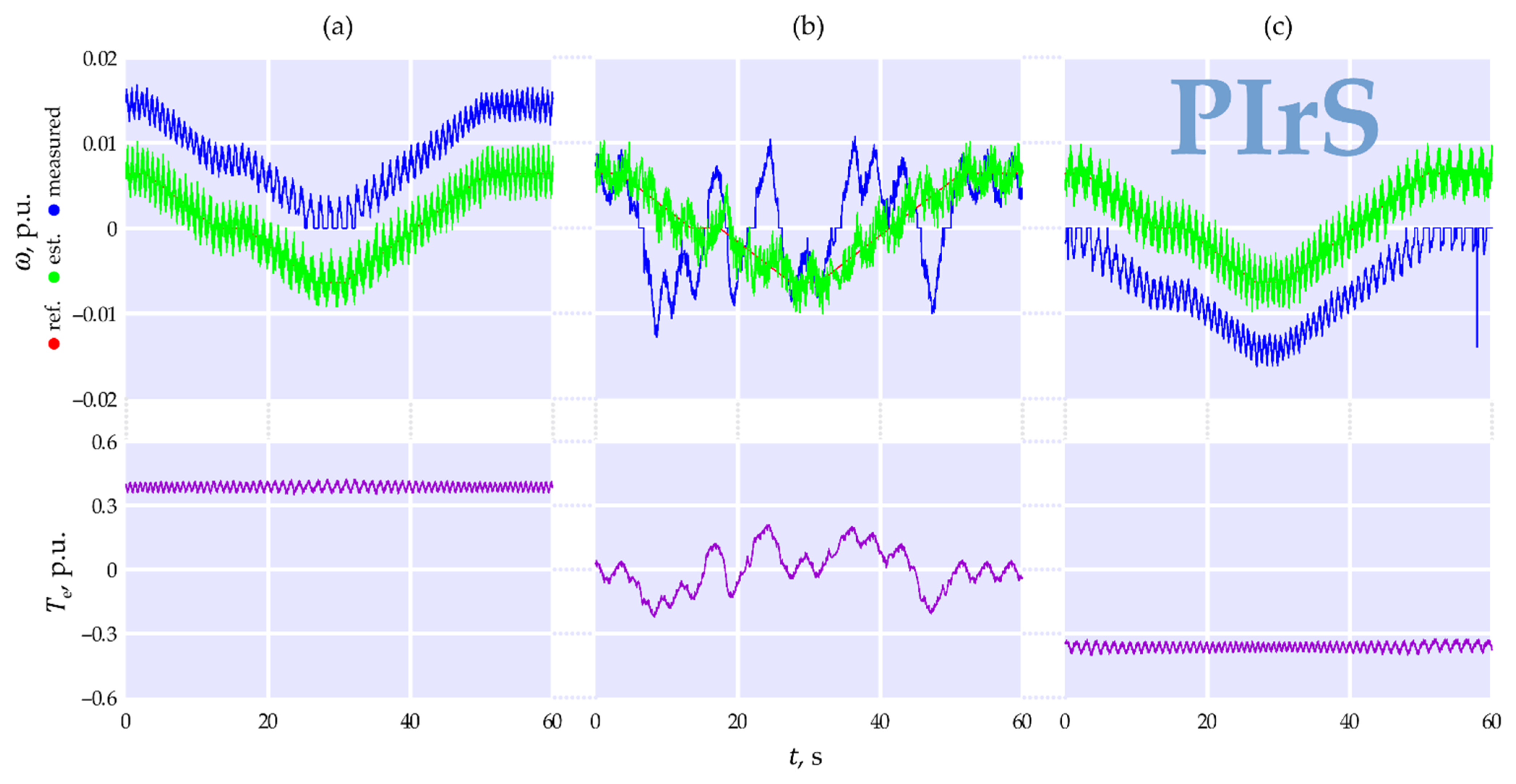
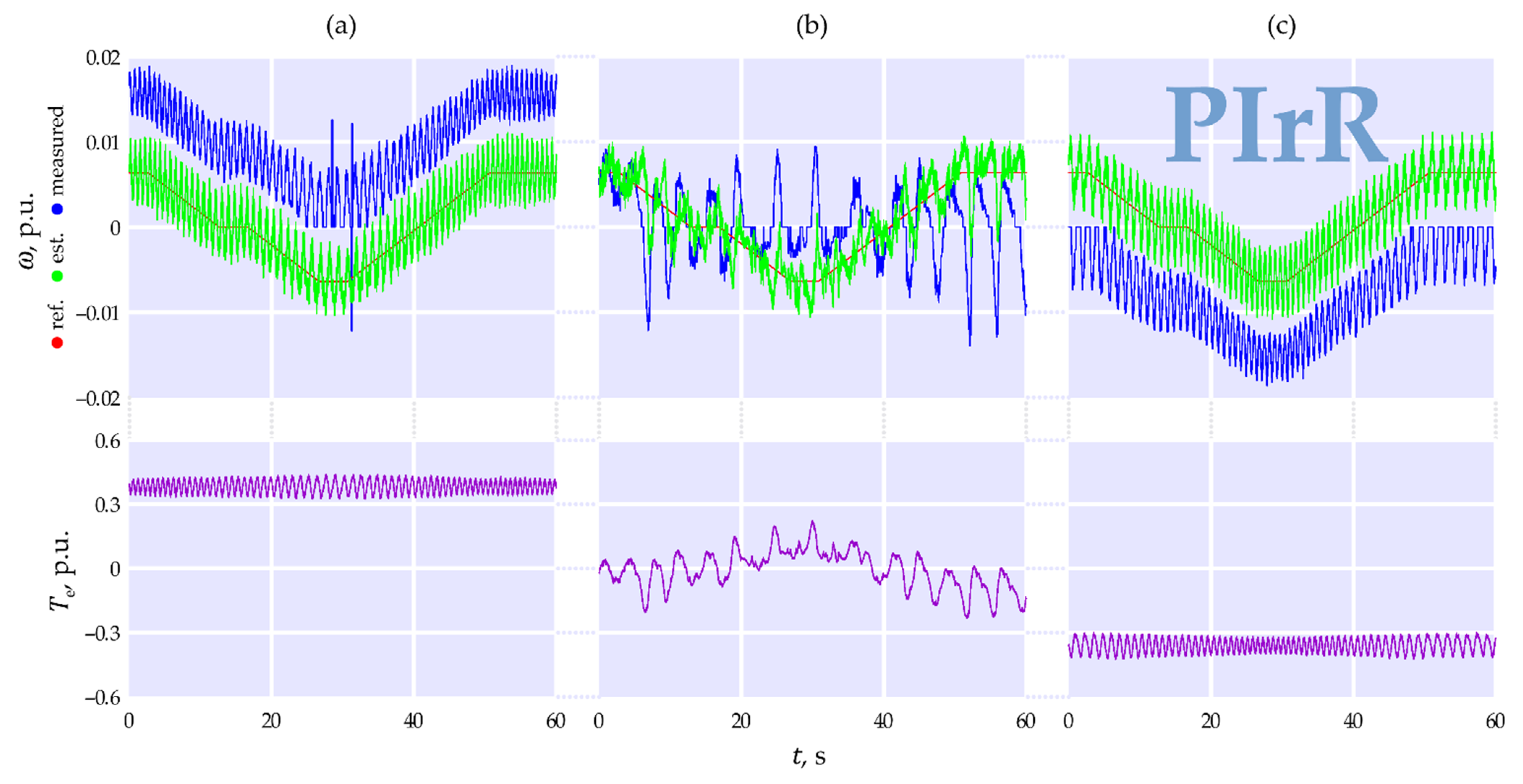
| Description | Symbol | Absolute Value | Per-Unit Value |
|---|---|---|---|
| Rated parameters | 400 V | 1 p.u. | |
| 14.6 A | 0.577 p.u. | ||
| 7.5 kW | - | ||
| 49.4 Nm | 0.767 p.u. | ||
| 1 | 1450 rpm () | - | |
| 50 Hz | - | ||
| Base quantities | 400 V | 1 p.u. | |
| 25.29 A | 1 p.u. | ||
| 314.2 rad/s | 1 p.u. | ||
| 3.183 ms | 1 p.u. | ||
| 15.82 Ω | 1 p.u. | ||
| 0.05035 H | 1 p.u. | ||
| 1.273 Wb | 1 p.u. | ||
| 64.39 Nm | 1 p.u. | ||
| Equivalent circuit parameters | 0.56 Ω | 0.0354 p.u. | |
| 0.72 Ω | 0.04552 p.u. | ||
| 0.1226 H | 2.435 p.u. | ||
| 0.1226 H | 2.435 p.u. | ||
| 0.1183 H | 2.35 p.u. |
| Observer | |||||||
|---|---|---|---|---|---|---|---|
| PIrS | 0 | −0.1406 | 0.0682 | 0 | −0.02133 | −0.03175 | 10 |
| PIrR | −0.1927 | 0.01944 | −0.1063 | 0 | 0.033 | 0.1135 | 10 |
Publisher’s Note: MDPI stays neutral with regard to jurisdictional claims in published maps and institutional affiliations. |
© 2021 by the authors. Licensee MDPI, Basel, Switzerland. This article is an open access article distributed under the terms and conditions of the Creative Commons Attribution (CC BY) license (https://creativecommons.org/licenses/by/4.0/).
Share and Cite
Białoń, T.; Niestrój, R.; Michalak, J.; Pasko, M. Induction Motor PI Observer with Reduced-Order Integrating Unit. Energies 2021, 14, 4906. https://doi.org/10.3390/en14164906
Białoń T, Niestrój R, Michalak J, Pasko M. Induction Motor PI Observer with Reduced-Order Integrating Unit. Energies. 2021; 14(16):4906. https://doi.org/10.3390/en14164906
Chicago/Turabian StyleBiałoń, Tadeusz, Roman Niestrój, Jarosław Michalak, and Marian Pasko. 2021. "Induction Motor PI Observer with Reduced-Order Integrating Unit" Energies 14, no. 16: 4906. https://doi.org/10.3390/en14164906
APA StyleBiałoń, T., Niestrój, R., Michalak, J., & Pasko, M. (2021). Induction Motor PI Observer with Reduced-Order Integrating Unit. Energies, 14(16), 4906. https://doi.org/10.3390/en14164906






